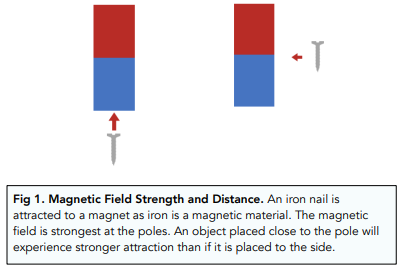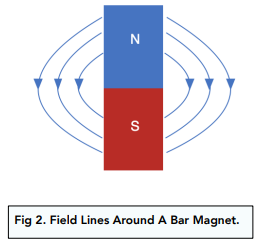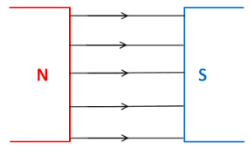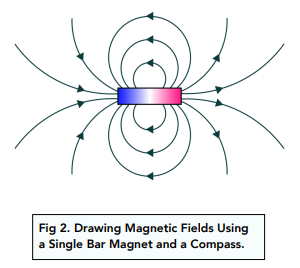Magnetic Fields (GCSE Physics)
Magnetic Fields
Defining Magnetic Fields
Exams may ask you to define the term ‘magnetic field’. Here’s a simple definition to answer those types of questions.
The magnetic field is the region around a magnet where a force acts on another magnet or magnetic material (iron, steel, cobalt and nickel).
Forces in Magnetic Fields
- Magnets exert forces. We have mentioned this several times before, but it is important to remember that the poles of a magnet will exert forces. These forces can either be a force of attraction or a force of repulsion.
- Magnetic materials experience forces. When we place a magnet next to certain materials, they will experience a force of attraction. These certain materials are known as magnetic materials. They will always be attracted to magnets.
Strength of Magnetic Fields
- Distance is important. The distance in between the magnet and the magnetic object is very important when determining the strength of the magnetic field. The closer we hold an object to the magnet, the stronger the magnetic field will be.
- The field strength is strongest at the poles. As we discussed previously, the magnetic field is strongest at the poles of the magnet. This means that if an object is placed close to the pole of a magnet, then it will experience a stronger magnetic field than if it was simply placed to the side.

Direction of Magnetic Fields
- We can find the direction of a magnetic field. We can find the direction of a magnetic field quite simply by using force. This ‘force’ is the force that will act on the north pole of the magnet from that point.

- Magnetic field lines run from north to south. If we take a bar magnet (or any permanent magnet), we can plot the field lines around the magnet. These field lines will denote the shape of the magnetic field. The important thing to remember is that these field lines will run from the north pole of the magnet to the south pole of the magnet.
Uniform Magnetic Fields
- Two opposite poles form a uniform magnetic field. Placing the opposite poles of two magnets close to each other will produce a uniform magnetic field.
- The strength and direction is constant. The strength and direction of the magnetic field will be the same at any point in the field.

Magnetic Compass
- A magnetic compass has a bar magnet. This magnet has north and south poles. These poles can be attracted to the magnetic north or magnetic south pole of the Earth.
- Compasses use the Earth’s magnetic field. We can align the magnet to find the direction of the Earth’s magnetic field. This is because the north pole of the magnet will point towards the Earth’s magnetic south pole.
Drawing Magnetic Fields
We can draw magnetic fields in one of two ways; by using a bar magnet, or by using a magnetic compass. We’ll explore these in more detail in this section.
Using a Bar Magnet
- Place a bar magnet onto a piece of paper and draw around it. Label one end North, and the other end as South.
- Place a bar magnet onto a piece of paper and draw around it. The field lines should run away from the North Pole of the magnet, towards the South Pole, as shown in the image.
Using a Magnetic Compass
- Place a bar magnet onto a piece of paper and draw around it. Label one end North, and the other end as South.
- Place a magnetic compass on the paper. Make sure that the compass is close to the North Pole of the magnet. On the piece of paper, draw on a small arrow in the direction that the compass is pointing.
- Move the magnetic compass away from the North Pole, towards the South pole. Continue to mark the arrows onto the piece of paper.
- You should end up with a series of arrows running from North-South. Repeat this at various points around the magnet, until you get a diagram like the one shown.

Behaviour of A Magnetic Compass
- Magnetic compasses rely on the Earth. Magnetic compasses ‘line up’ in the direction of the magnetic field of the Earth.
- The Earth is magnetic. The Earth is magnetic as it affects magnetic compasses and produces a magnetic field.
A magnetic field is an invisible force field that is produced by magnets or moving charges. It can be visualized using magnetic field lines, which indicate the direction and strength of the field.
Magnetic fields have several properties, including direction, strength, and polarity. They can be attracted or repelled by other magnetic fields and can influence the motion of charged particles.
Electricity and magnetism are closely related, as changing electric fields produce magnetic fields, and changing magnetic fields produce electric fields. This relationship is known as electromagnetism and is the basis for many modern technologies.
A solenoid is a coil of wire that produces a magnetic field when an electric current is passed through it. Solenoids are used in many devices, including speakers, motors, and electromagnetic locks.
An electromagnet is a type of magnet that is created by passing an electric current through a coil of wire. The strength of the electromagnet can be controlled by changing the amount of current that is flowing through the coil.
The Earth has a magnetic field that is produced by the movement of molten iron in its core. This magnetic field helps to protect the Earth from harmful solar radiation and is responsible for the phenomenon of auroras.
Magnetic fields can affect the motion of charged particles, causing them to move in a curved path. This effect is used in devices such as cathode ray tubes, particle accelerators, and MRI machines.
A magnetic domain is a region of a magnetic material in which the magnetic fields of the atoms are all aligned in the same direction. This alignment creates a strong magnetic field within the domain.
Magnetic fields are used in many technologies, including generators, motors, speakers, and hard drives. They are also used in medical imaging, such as MRI machines, and in navigation systems, such as compasses and GPS devices.
Some people are concerned about the potential harmful effects of magnetic fields on human health. To protect yourself, you can limit your exposure to magnetic fields by avoiding high-voltage power lines, limiting your use of electronic devices, and using shielding materials. However, the scientific community has not yet established a clear link between magnetic fields and adverse health effects.





Still got a question? Leave a comment
Leave a comment